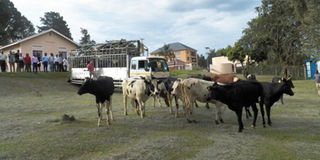Government to stop distributing free agricultural inputs

Farmers said that whereas heifers supplied under the Naads programme are supposed to be in-calf, many delivered by suppliers were not, while others have very low milk production. FILE PHOTO
What you need to know:
Buy inputs. Government now wants farmers to buy agricultural inputs and not rely on free inputs just like it is currently.
Government has started a process that will eliminate the distribution of free agricultural inputs and implements, according to a senior official at the Ministry of Agriculture.
The process, according to Ms Beatrice Byarugaba, the Ministry of Agriculture director of extension services, has already been kicked off with a memorandum of understanding (MoU) that will require accounting officers in the districts of Kalungu, Ntungamo, Iganga, Nebbi and Amuru eliminate the free provision of agricultural inputs from their budgeting activities.
Government, under Operation Wealth Creation (OWC), among other initiatives, distributes free agricultural inputs and implements to boost farming across the country.
The MoU, which was signed on the sidelines of the Joint Agricultural Sector Annual Review conference last week, spells out guidelines that district authorities and the Ministry of Agriculture are expected to undertake over a six-year pilot period.
The programme, which will act as a pilot project, was unveiled nearly two years ago with the aim of building a more sustainable agricultural sector.
The project is expected to cost about $150m (Shs565b) and will be rolled out to other 42 districts.
Under the Agriculture Cluster Development Project (ACDP) funded by the World Bank and implemented by the Ministry of Agriculture, government hopes to pursue a phased withdrawal from the free distribution of inputs, particularly seeds to the farmers.
“We want our farmers to be business people. We want them to start thinking and acting like business people. This is why we want them to invest in agriculture by buying inputs,” Dr Byarugaba said in an interview.
People (farmers), she said, waste free things, there by necessitating government to build a sustainable model that will make farmers invest in agriculture as a business.
Dr Byarugaba also said government hopes that the pilot project, which focuses on promoting particular crops in different districts, will increase on-farm productivity, production and marketable surpluses.
According to a statement issued by the Ministry of Agriculture last week, the project will be implemented in a cluster format with each cluster assigned a particular trial commodity covering on average three districts.
The cluster, the statement said, will facilitate concentrations of producers and agribusiness institutions, usually in the same sector, to work together in addressing common challenges and opportunities.
The cluster approach, government argues, will provide opportunities for economies of scale, utilisation of common market infrastructure, input and output bulking and enhanced value addition.
Lessons learned from the pilot districts will guide a phased roll out in the rest of the country except in the Karamoja sub-region which has been excluded because it has a different intervention scheme driven through the Regional Pastoral Livelihoods Resilience Project.
CAUTIONED AGAISNT MISUSE
In his remarks, Mr Pius Wakabi, the permanent secretary, who signed the memorandum of understanding on behalf of the Ministry Agriculture, cautioned that the Shs565b to be invested in the pilot project must be put to proper.
“The money is a loan and not a grant which we will pay with interest. For that matter it shouldn’t be wasted. It must bear fruits. We expect a successful implementation of the project,” he said.
The activities and investments to be supported under the Agriculture Cluster Development Project include on-farm production, market linkages, storage and value addition among others.
FOCUS
The Agriculture Cluster Development Project will focus on small holder farmers and other value chain actors at local, district and national levels as the key beneficiaries.
The pilot project will seek to focus on 450,000 households, which is expected to translate to about 2.2 million Ugandans across the 42 districts.
Funds will therefore be transferred to the participating district local governments to facilitate implementation of project activities.




